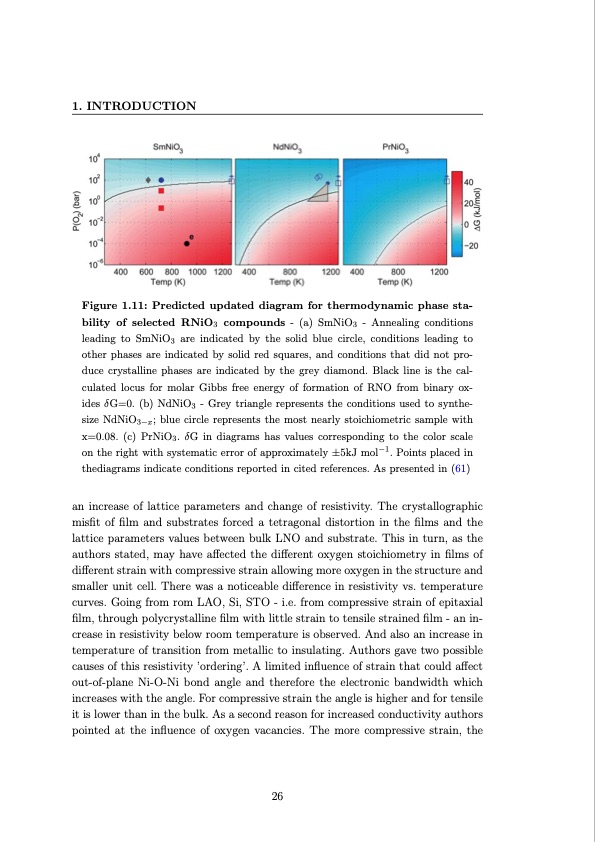
PDF Publication Title:
Text from PDF Page: 047
1. INTRODUCTION Figure 1.11: Predicted updated diagram for thermodynamic phase sta- bility of selected RNiO3 compounds - (a) SmNiO3 - Annealing conditions leading to SmNiO3 are indicated by the solid blue circle, conditions leading to other phases are indicated by solid red squares, and conditions that did not pro- duce crystalline phases are indicated by the grey diamond. Black line is the cal- culated locus for molar Gibbs free energy of formation of RNO from binary ox- ides δG=0. (b) NdNiO3 - Grey triangle represents the conditions used to synthe- size NdNiO3−x; blue circle represents the most nearly stoichiometric sample with x=0.08. (c) PrNiO3. δG in diagrams has values corresponding to the color scale on the right with systematic error of approximately ±5kJ mol−1. Points placed in thediagrams indicate conditions reported in cited references. As presented in (61) an increase of lattice parameters and change of resistivity. The crystallographic misfit of film and substrates forced a tetragonal distortion in the films and the lattice parameters values between bulk LNO and substrate. This in turn, as the authors stated, may have affected the different oxygen stoichiometry in films of different strain with compressive strain allowing more oxygen in the structure and smaller unit cell. There was a noticeable difference in resistivity vs. temperature curves. Going from rom LAO, Si, STO - i.e. from compressive strain of epitaxial film, through polycrystalline film with little strain to tensile strained film - an in- crease in resistivity below room temperature is observed. And also an increase in temperature of transition from metallic to insulating. Authors gave two possible causes of this resistivity ’ordering’. A limited influence of strain that could affect out-of-plane Ni-O-Ni bond angle and therefore the electronic bandwidth which increases with the angle. For compressive strain the angle is higher and for tensile it is lower than in the bulk. As a second reason for increased conductivity authors pointed at the influence of oxygen vacancies. The more compressive strain, the 26PDF Image | Investigation of metal-insulator transition in magnetron sputtered samarium nickelate thin films

PDF Search Title:
Investigation of metal-insulator transition in magnetron sputtered samarium nickelate thin filmsOriginal File Name Searched:
Bilewska_Investigation_of_metal_insulator_transition_in_magnetron_sputtered_samarium.pdfDIY PDF Search: Google It | Yahoo | Bing
Sulfur Deposition on Carbon Nanofibers using Supercritical CO2 Sulfur Deposition on Carbon Nanofibers using Supercritical CO2. Gamma sulfur also known as mother of pearl sulfur and nacreous sulfur... More Info
CO2 Organic Rankine Cycle Experimenter Platform The supercritical CO2 phase change system is both a heat pump and organic rankine cycle which can be used for those purposes and as a supercritical extractor for advanced subcritical and supercritical extraction technology. Uses include producing nanoparticles, precious metal CO2 extraction, lithium battery recycling, and other applications... More Info
| CONTACT TEL: 608-238-6001 Email: greg@infinityturbine.com | RSS | AMP |